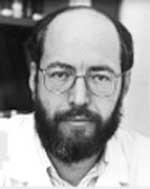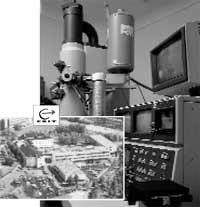Jose Mari Rodriguez Ibabe, on the steel slope
(Centro de Estudios e Investigaciones Técnicas de Guipúzcoa)
In the San Sebastian neighborhood of Ibaeta is the School of Engineering of the University of Navarra, where the tutored research center CEIT is located. Dr. Jose Mari Rodriguez Ibabe works on him. We talked to him about research.
Feb.- A normal day, what do you do when you come to work?
JMRI.- I am currently working on three or four different projects. I distribute the day as follows: tomorrow or part of it working on one project and then in the afternoon on another. The schedule is not very concrete. I spend a lot of time with doctoral students or interns, analyzing and discussing their work and their results. In short, ours is a team work and the debate is very necessary for the establishment and achievement of the objectives.
Elh.- How far do you send your hands at work?

JMRI.- Unfortunately recently very little. No essay. I use the scanning electron microscope at most. I, so to speak, have or have project management. The truth is that the projects have a director and under it there are two or three people working with staff, researchers. The project may have two or three branches and I am responsible for one of them.
Elh.- Is it a normal evolution in the life of the researcher?
JMRI.- It seems so. As age increases it is increasingly difficult to work in the laboratory. Of course if you know how to work or apply this technique in the laboratory. When you ask someone for something you have to know how it is done and what work is behind it. It is very dangerous if not.
Elh.- What is your area of work?
JMRI.- Right now I am very involved in metallurgy, especially in steels and metal matrix composites. In the steel sector, for example, we are in contact with all the companies of Gipuzkoa (CAF, Ucin, Tubes Assembled, etc. ). Our objectives are to improve the steel, improve the process or find new solutions to the type of steel being worked. It is a work closely related to reality.
Elh.- As for new materials?
JMRI.- We work with aluminum matrix composites. We are developing a new procedure called fusion formation. It is that in semi-solid state, not yet solidified, when shaping the material. Although the procedure is not fully established, it seems that very positive results can be obtained. We do it with aluminum/silicon alloys. This is the procedure to be followed in the small Sestao mill. Steel will begin to form before solidifying. This will mean energy savings that will result in lower product cost.
Elh.- Here you have worked with CEIT ceramic materials, right?
JMRI.- I don't. In the apartment yes. Something curious has happened with these materials. A few years ago you wanted to work with steel when you were asking for money they told you: “Are you in the head? That's last century material! Now politics has changed radically, even in Europe, and it is very difficult to get money to investigate new materials.
Elh.- Why do things like that happen?
JMRI.- Those who make the decision are politicians and who knows how they are informed. Sometimes the blame is on researchers. When the researcher seeks money, he tries to sell his product and tells him this or that. Seven or eight years later the politician sees no concrete consequences and cuts all the money. Long-term planning is not often seen.
Elh.- Do ceramic materials have a future or are they a product of fashion?

JMRI.- In fact, last month there was a congress in Donostia about material breakage. Ashby, a prestigious researcher, raised the doubt that ceramic materials were not very high and can be used. The next day, Dr. Moya said the opposite, stressing that the future depends on ceramics. In view of this, he wonders which of them is right. Both will be right if necessary. Moya spoke of very special examples, such as the heat shields of supersonic planes. In everyday life, however, ceramics will not be as useful and other materials will be used in which Ashby is right. When do we work at 2,000°C? In very few cases.
In the US and Japan they can investigate what they want, the resources are so great! But we do not. We will have to see what our industry is and what it needs and fulfill it. Once this is done, if there are ways, we can turn to other things.
Elh.- You just quoted reality. What relationship does your work have with reality?
JMRI.- Our projects are closely related to industry and industry. That is very important. When five years ago we went to the industry and told them that they had to change something in their process, they did not trust. Now, instead, they trust and that is not a joke. In fact, 100 tons can be at stake. We are doing applied research, but the concepts we use come from basic research. The steel industry, although common, is not the kitchen, but the science being worked on in universities. To understand the behavior of steel it is necessary to study the microstructure and use the electronic transmission microscope. That 20 years ago was impossible.
This concludes the transcript of what Jose Mari Rodriguez Ibabe told us. For lack of space, many interesting things have remained in the magnetophon.
- Born in San Sebastian in 1958
- Engineer at the University of Navarra
- Doctor at the University of Navarra
- CEIT researcher since 1982
- Professor at the School of Engineers of the University of Navarra since 1986
- He has published three books on metallurgy in Basque
- Sponsored research center created in 1982
- Areas of work: materials (metallurgy and new materials), applied mechanics, electricity, electronics and automatic, environmental engineering and microelectronics
- 57 staff researchers and 63 fellows
- Research funding: 40% contracts with companies, 30% Basque Government, 12% Madrid Government, 8% Gipuzkoa Provincial Council and 7% Europe
Buletina
Bidali zure helbide elektronikoa eta jaso asteroko buletina zure sarrera-ontzian











